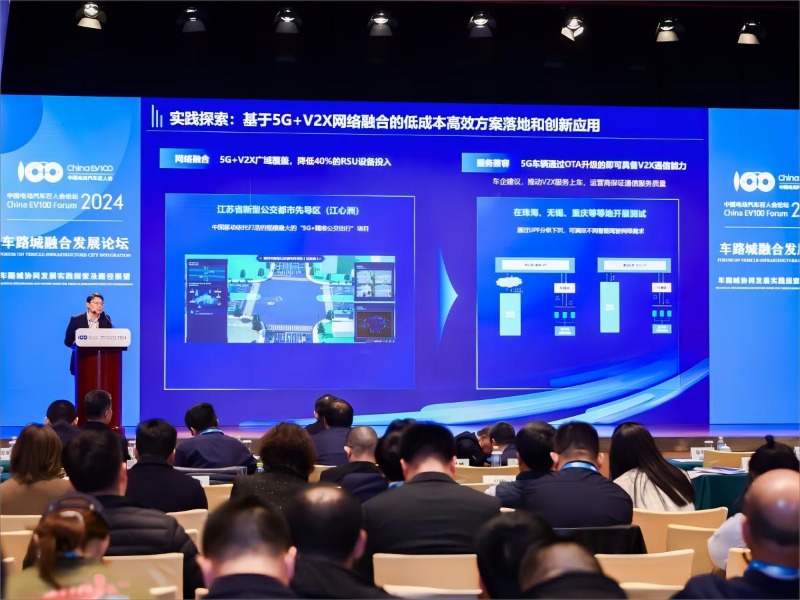China Mobile Creates "Four-integration" Internet of Vehicles Solution
From March 15th to 17th, the China Electric Vehicles 100 Forum (2024) with the theme of "Consolidating and Expanding the Development Advantages of New Energy Vehicles" was held at the Diaoyutai State Guesthouse in Beijing. At the Chelu City sub-forum on the 15th, Huang Gang, deputy general manager of China Mobile Research Institute, made a speech about the "four integrations" of the Internet of Vehicles industry, which attracted industry attention.

At the beginning of 2024, China Mobile Chairman Yang Jie proposed the idea of actively grasping the trend of the "AI+" era and promoting the extension of "5G+" to "AI+". Based on this, the Shanghai Research Institute has delved into 5G-A technology to build a new infrastructure of "ubiquitous integration" to provide integrated services of information perception, transmission, storage and processing for AI+ applications.

Technology Empowerment and Ubiquitous Integration
Based on industry needs in the field of Internet of Vehicles, China Mobile continues to carry out innovative exploration and implementation practices with Chinese characteristics. It is against this background that the four integration concepts of 5G+V2X communication integration, vehicle-road computing power integration, vehicle+city+cloud integration, and people+vehicle+home integration were proposed.
From 5G to 5G-A, the Shanghai Research Institute has used China Mobile's strong basic network capabilities to keep pace with industry needs and continuously evolve to provide users with low-latency, wide coverage, stable and reliable communication services. China Mobile's 5G-A+V2X partially enhanced converged networking can ensure data follow-up delivery, entrance delivery and adaptive variable range delivery, achieving car cloud information service latency as low as 20ms@99%, Excellent results with wide area coverage and low comprehensive cost.
Vehicle-road computing power is integrated, with low-latency computing power to meet roadside perception calculations, and hierarchical large computing power to support vehicle-side data processing. The roadside is based on AI deep learning detection algorithms and improves the identification and prediction of traffic elements through perception models. Accuracy, achieving a fusion perception recognition rate of no less than 95%, effectively making up for the vehicle-side perception field of view and accuracy, and there is no shortage of intelligent computing and supercomputing to support large model training. The characteristics of cloud-edge collaboration and on-demand deployment ensure the computing power needs of different applications, reducing computing power investment by 10%-35%, forming a safe, trustworthy, stable and reliable unified operation and maintenance management and guarantee system.
Car + City + Cloud Integration is to connect and empower the dynamic traffic information provided by the city with the vehicle-side sensing shared information provided by the vehicle. The Shanghai Academia Sinica uses a large AI traffic sensing model to achieve multi-task accurate sensing in the cross-domain transportation system. , effectively improves the generalization ability of collaborative sensing in urban traffic scenarios, eliminates customized rules in the implementation process of the model, and is widely used in downstream tasks such as scene understanding, situational awareness, and intelligent decision-making to achieve multi-task collaboration in cross-domain transportation systems. Efficiency optimization improves the overall traffic efficiency of the city. Carry out real-time monitoring of vehicle operating safety status, and achieve cross-model and cross-city interconnection and mutual recognition to achieve a win-win effect of convenient travel and adequate supervision.
The integration of people + cars + homes is a convergence ecosystem, creating an integrated application of connections + applications + rights. The Shanghai Research Institute integrates China Mobile's national, local and car company channels to carry out activities to attract traffic, joint marketing, and channel value sharing, forming an efficient full-chain operation service closed loop of "all-area smart operations" + "deep integration of content rights", with refinement It has the advantages of integrated operation, multi-touch-point operation for people, vehicles and home, as well as a diverse content ecology.
Innovative Application Demonstration Benchmark
In February 2024, Shanghai Pudong Jinqiao Intelligent Connected Vehicle Demonstration Zone opened the world's first 5G-A connected car demonstration route. This route relies on multiple 5G-A technologies and AI capabilities of the Shanghai Academia Sinica to realize the integration of vehicles, roads, networks, and clouds. , map-to-all-factor verification, which is at the forefront domestically and even globally, and has attracted widespread attention as soon as it was released.
The total length of the demonstration route is about 1 km. Based on visual AI and synaesthesia integration technology, the Shanghai Academia Sinica uses target detection and tracking, data fusion and other optimization methods to sense and locate objects in the target area and improve the detection and identification of abnormal road traffic events. Accuracy, and through the self-developed 5G broadcast system to achieve accurate vehicle-road collaborative information services, provide real-time information on traffic accidents, pedestrian intrusions and other information to vehicles driving on the road, which is like "opening the eyes" for autonomous driving, reducing the occurrence of traffic accidents and improving improve the safety and efficiency of transportation. In addition, China Mobile has joined hands with Huawei and Neolithic to create a "cloud-edge-device" autonomous driving data closed-loop system to help 5G-A enable the large-scale commercialization of L4 autonomous vehicles, saving nearly 30% of computing power for the vehicle end. power expenditure.
In the next stage, China Mobile Research Institute will continue to deepen the layout of 5G-A Internet of Vehicles, comprehensively promote the improvement of "four integrations" capabilities, empower the integrated construction of vehicle, road and cloud, and continue to stimulate the potential of 5G, computing power network and other technologies to accelerate the Contribute to the development of new productive forces.